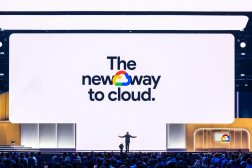- Sponsored
- Modernization
Unlocking the power of the cloud

Kristie Grinnell is GDIT’s global chief information officer and vice president for supply chain where she leads the company’s enterprise IT strategy and works with federal agencies to support their digital modernization.

Kristie Grinnell, Global Chief Information Officer and VP, Supply Chain, GDIT
Challenges over the past year have forced federal agencies to reconsider their strategic IT road maps. But there’s a larger reason for adjusting course. Agencies are also reaching an inflection point, at which it’s become critical for federal officials focus more fully on their hybrid cloud journey.
Those who’ve already made the leap to the cloud have learned, perhaps the hard way, that each of the major cloud service providers has its own unique strengths and operating requirements. But to fully leverage the power and capabilities of the cloud, it’s crucial that agencies and their components take a step back to make sure they truly understand their data strategies first — and then determine which cloud is best suited to their needs, and why.
It’s equally important that agencies understand what they’re going to be doing in the cloud once they get there — and, longer term, how they plan to integrate the outcomes back into their operations. If you don’t make those decisions properly up front, chances are, your data may very well end up in the wrong cloud.
As the global CIO at GDIT — a company that has a long history of working with government agencies — I’ve experienced those lessons first hand as we went through our own cloud journey. And I’ve come to appreciate they’re particularly important for federal agencies.
Today, GDIT uses a combination of cloud service providers as well as our own, significantly consolidated, on-prem data centers to meet our infrastructure and platform needs. There are several reasons we opted to work with multiple cloud providers.
One basic reason was to prevent vendor lock-in. But more importantly, it also was to make sure we were able to manage our data in the most appropriate environments. And of course, having the right level of security has always been a monumental concern with our agency customers. So is how our thousands of employees and engineers interact with agencies and that data every day.
That journey began by developing a playbook to systematically review our data requirements and determine which cloud services were best-suited to our, and our customers’ needs, including a heavy emphasis on security assurances. We then tested direct connections to respective cloud providers and developed containers to see what worked best. Finally, we moved full speed ahead to take advantage of all that cloud has to offer, including AI and ML, automation, scalability and greater analytic capabilities.
Starting with the right questions
What we learned along the way, though, is that the technical hurdles moving to different clouds are only part of the challenge. A critical question becomes, do you have sufficient talent to get you there — and the right mix of people who understand what’s involved, how different clouds work and the gaps in between?
One reason federal agencies continue to turn to GDIT, for instance, is the breadth and depth of experience among our 14,000-plus cleared professionals — including more than 3,000 cloud specialists supporting federal and state/local government. Our teams have helped set up more than 60,000 different cloud instances across multiple cloud service providers, including AWS, Microsoft Azure, Google Cloud, IBM and Oracle. And we currently work with more than 50 cloud partners. With every engagement, we began by asking: “What type of data do you have? How sensitive is it? What do you want to do with it when you get there? Who needs access to it?”
The other big challenge is the organizational change required — helping people to understand the rationale for change and their role in the future state. We know because we’ve got scars on our back from our own cloud journey — as well as through our experience partnering with agencies as they went through similar transitions.
Building on experience
Collectively, we’ve learned the more scale you have, the more automation you need — whether you’re modernizing on-prem or in the cloud — and that can shift the roles and workloads throughout an organization. That’s where the benefits of experience can help.
At the Centers for Medicare and Medicaid Services (CMS), which operates one of the largest public clouds in the federal government, we have been providing cloud services for the past five years and recently won a new contract for up to an additional four more years. GDIT is standardizing multi-cloud environments for CMS and will implement a range of cloud services, cloud training, tools and software and simplify the financial management of cloud services.
In another example, GDIT helped the Defense Department establish a fit-for-purpose, self-service commercial cloud service within DOD’s network and facilities. By providing critical security controls, including IL-5 security standards (IL-6 coming soon), plus the ability to procure cloud services within in hours, rather than the traditional 16-to-18 month acquisition cycle, DOD mission partners can fast-track the use of AI and ML applications and other emerging solutions.
Our cloud specialists also have a unique understanding of what’s involved in rolling out cloud services at scale. That’s one reason GDIT was awarded a contract to help improve information sharing and collaboration across the DOD with the largest-ever deployment of Microsoft Office 365, to more than 3.2 million users.
What those and countless other projects have taught us is the fundamental importance of constantly re-skilling and up-upskilling of your workforce, in order to take advantage of all the changes and services that the big cloud providers keep rolling out.
Our extensive relationships with all of the major cloud providers, the many partners they work with, and our agnostic approach to finding the right solutions for agencies, are among just some of reasons why federal agencies continue to see the advantage of engaging GDIT’s experts to help them capitalize on the cloud faster and more effectively.
Five years from now, chances are, we won’t be talking much anymore about transitioning to the cloud. Instead, we’ll be talking about all the ways government agencies are leveraging their data using the power of the cloud. But that vision depends on getting your data and cloud strategies properly mapped out today — and having the right talent in place to help you.
Learn more about how GDIT can help your agency with its cloud and digital modernization efforts.






